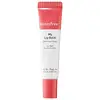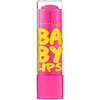What's inside
What's inside
 Key Ingredients
Key Ingredients

 Benefits
Benefits

 Concerns
Concerns

 Ingredients Side-by-side
Ingredients Side-by-side

Petrolatum
EmollientHydrogenated Castor Oil Dimer Dilinoleate
Skin ConditioningMicrocrystalline Wax
Emulsion StabilisingBeeswax
Emulsion StabilisingSimmondsia Chinensis Seed Oil
EmollientHelianthus Annuus Seed Oil
EmollientTheobroma Grandiflorum Seed Butter
Skin ConditioningSilica Silylate
EmollientCitrus Aurantium Bergamia Fruit Oil
MaskingCaprylic/Capric Triglyceride
MaskingIsostearic Acid
CleansingDimer Dilinoleyl Dimer Dilinoleate
EmollientDiisostearyl Malate
EmollientTocopheryl Acetate
AntioxidantDehydroacetic Acid
PreservativeCI 77491
Cosmetic ColorantCI 45410
Cosmetic ColorantCitric Acid
BufferingCI 77891
Cosmetic ColorantMentha Piperita Oil
MaskingCI 15985
Cosmetic ColorantSodium Saccharin
MaskingCI 15850
Cosmetic ColorantCI 77492
Cosmetic ColorantTocopherol
AntioxidantWater
Skin ConditioningGlycerin
HumectantButylene Glycol
HumectantCamellia Sinensis Leaf Extract
AntimicrobialCitrus Unshiu Peel Extract
MaskingOpuntia Coccinellifera Fruit Extract
Skin ConditioningOrchid Extract
Skin ConditioningCamellia Japonica Leaf Extract
Skin ConditioningCitrus Sudachi Fruit Extract
Humectant1,2-Hexanediol
Skin ConditioningPetrolatum, Hydrogenated Castor Oil Dimer Dilinoleate, Microcrystalline Wax, Beeswax, Simmondsia Chinensis Seed Oil, Helianthus Annuus Seed Oil, Theobroma Grandiflorum Seed Butter, Silica Silylate, Citrus Aurantium Bergamia Fruit Oil, Caprylic/Capric Triglyceride, Isostearic Acid, Dimer Dilinoleyl Dimer Dilinoleate, Diisostearyl Malate, Tocopheryl Acetate, Dehydroacetic Acid, CI 77491, CI 45410, Citric Acid, CI 77891, Mentha Piperita Oil, CI 15985, Sodium Saccharin, CI 15850, CI 77492, Tocopherol, Water, Glycerin, Butylene Glycol, Camellia Sinensis Leaf Extract, Citrus Unshiu Peel Extract, Opuntia Coccinellifera Fruit Extract, Orchid Extract, Camellia Japonica Leaf Extract, Citrus Sudachi Fruit Extract, 1,2-Hexanediol
Polybutene
Octyldodecanol
EmollientIsopropyl Myristate
EmollientPetrolatum
EmollientEthylhexyl Methoxycinnamate
UV AbsorberPolyethylene
AbrasiveOzokerite
Emulsion StabilisingEthylhexyl Salicylate
UV AbsorberButyrospermum Parkii Butter
Skin ConditioningDiisostearyl Malate
EmollientCandelilla Cera
EmollientVp/Hexadecene Copolymer
Silica Dimethyl Silylate
EmollientParfum
MaskingCalcium Aluminum Borosilicate
Pentaerythrityl Tetra-Di-T-Butyl Hydroxyhydrocinnamate
AntioxidantTocopherol
AntioxidantTocopheryl Acetate
AntioxidantAlumina
AbrasiveAroma
Silica
AbrasiveIsopropyl Palmitate
EmollientPentaerythrityl Tetraisostearate
EmollientLimonene
PerfumingSynthetic Fluorphlogopite
Calcium Sodium Borosilicate
Benzyl Benzoate
AntimicrobialCentella Asiatica Extract
CleansingAluminum Hydroxide
EmollientCitral
PerfumingLinalool
PerfumingHexyl Cinnamal
PerfumingTin Oxide
AbrasiveGeraniol
PerfumingEugenol
PerfumingAloe Barbadensis Extract
Skin ConditioningMel
EmollientCalcium Pantothenate
Ascorbic Acid
AntioxidantDimethicone
EmollientSodium Chondroitin Sulfate
Skin ConditioningAtelocollagen
Skin ConditioningCI 77891
Cosmetic ColorantMica
Cosmetic ColorantCI 45410
Cosmetic ColorantCI 77491
Cosmetic ColorantCI 77492
Cosmetic ColorantCI 77499
Cosmetic ColorantCI 15850
Cosmetic ColorantCI 45380
Cosmetic ColorantCI 19140
Cosmetic ColorantCI 42090
Cosmetic ColorantCI 15985
Cosmetic ColorantCI 75470
Cosmetic ColorantPolybutene, Octyldodecanol, Isopropyl Myristate, Petrolatum, Ethylhexyl Methoxycinnamate, Polyethylene, Ozokerite, Ethylhexyl Salicylate, Butyrospermum Parkii Butter, Diisostearyl Malate, Candelilla Cera, Vp/Hexadecene Copolymer, Silica Dimethyl Silylate, Parfum, Calcium Aluminum Borosilicate, Pentaerythrityl Tetra-Di-T-Butyl Hydroxyhydrocinnamate, Tocopherol, Tocopheryl Acetate, Alumina, Aroma, Silica, Isopropyl Palmitate, Pentaerythrityl Tetraisostearate, Limonene, Synthetic Fluorphlogopite, Calcium Sodium Borosilicate, Benzyl Benzoate, Centella Asiatica Extract, Aluminum Hydroxide, Citral, Linalool, Hexyl Cinnamal, Tin Oxide, Geraniol, Eugenol, Aloe Barbadensis Extract, Mel, Calcium Pantothenate, Ascorbic Acid, Dimethicone, Sodium Chondroitin Sulfate, Atelocollagen, CI 77891, Mica, CI 45410, CI 77491, CI 77492, CI 77499, CI 15850, CI 45380, CI 19140, CI 42090, CI 15985, CI 75470
 Reviews
Reviews

Ingredients Explained
These ingredients are found in both products.
Ingredients higher up in an ingredient list are typically present in a larger amount.
Ci 15850 is the pigment color red. It is an azo dye and created synthetically.
Azo dyes need to be thoroughly purified before use. This allows them to be more stable and longer-lasting.
This ingredient is common in foundations, lipsticks, and blushes. This color is described as brown/orangey red.
It has many secondary names such as Red 6 and Red 7. According to a manufacturer, Red 6 usually contains aluminum.
Learn more about CI 15850Ci 15985 is a dye made from petroleum. It is synthetically created and approved by the FDA for use in foods and cosmetics.
The color of this dye is orange/yellow.
This ingredient can be found in makeup, sun care, and skincare.
Learn more about CI 15985CI 45410 is a synthetic red-pigment and dye.
It often goes by both Red 28 or Red 27; manufacturers label both ingredients as CI 45410.
This dye is commonly found in makeup because it imparts a vivid color. Some types of this dye change color based on pH level and interaction with moisture:
Your skin has a natural pH of around 4.5 - 5.5.
According to the FDA, CI 45410 is not permitted for use in eye products.
Red 27 is a flourescein dye and commonly used as a fluorescent tracer in medicine.
Learn more about CI 45410Ci 77491 is also hydrated iron III oxide. It's sole purpose is to give a red/pink hue to products.
Iron III oxides are classified as inorganic chemicals for coloring.
Synthetically created Ci 77491 is considered safer than those naturally found. This is because the synthetically created version may contain less impurities. Iron oxides are generally non-toxic and non-allergenic.
Learn more about CI 77491Ci 77492 is also hydrated iron III oxide. It's sole purpose is to give a yellow hue to products.
Iron III oxides are classified as inorganic chemicals for coloring.
Synthetically created Ci 77492 is considered safer than those naturally found. This is because the synthetically created version may contain less impurities. Iron oxides are generally non-toxic and non-allergenic.
Learn more about CI 77492Ci 77891 is a white pigment from Titanium dioxide. It is naturally found in minerals such as rutile and ilmenite.
It's main function is to add a white color to cosmetics. It can also be mixed with other colors to create different shades.
Ci 77891 is commonly found in sunscreens due to its ability to block UV rays.
Learn more about CI 77891Diisostearyl Malate is an emollient and most often used in lip products. It comes from isostearyl alcohol, a fatty acid, and malic acid, an AHA.
As an emollient, Diisostearyl Malate helps create a thin film on your skin to trap moisture in. This helps keep your skin soft and smooth.
Petrolatum is more commonly known as petroleum jelly. It is created by mixing waxes and mineral oils.
This ingredient is effective at reducing water loss by 99%. This is because it is an occlusive. Occlusives create a hydrophobic barrier on the skin to prevent evaporation. This property makes it great for hydrating dry skin.
Pro tip: Use occlusives, such as this ingredient, on damp skin for the best results.
The quality or origin of petrolatum is only known when disclosed by the brand. Most cosmetic petrolatum has gone through several purification stages.
Another benefit of occlusives is it protects your skin against infection or allergies.
Petrolatum may not be safe for fungal-acne. Studies show mineral oil / petroleum leads to the growth of M. Furfur, a type of yeast.
Learn more about PetrolatumTocopherol (also known as Vitamin E) is a common antioxidant used to help protect the skin from free-radicals and strengthen the skin barrier. It's also fat soluble - this means our skin is great at absorbing it.
Vitamin E also helps keep your natural skin lipids healthy. Your lipid skin barrier naturally consists of lipids, ceramides, and fatty acids. Vitamin E offers extra protection for your skin’s lipid barrier, keeping your skin healthy and nourished.
Another benefit is a bit of UV protection. Vitamin E helps reduce the damage caused by UVB rays. (It should not replace your sunscreen). Combining it with Vitamin C can decrease sunburned cells and hyperpigmentation after UV exposure.
You might have noticed Vitamin E + C often paired together. This is because it is great at stabilizing Vitamin C. Using the two together helps increase the effectiveness of both ingredients.
There are often claims that Vitamin E can reduce/prevent scarring, but these claims haven't been confirmed by scientific research.
Learn more about TocopherolTocopheryl Acetate is AKA Vitamin E. It is an antioxidant and protects your skin from free radicals. Free radicals damage the skin by breaking down collagen.
One study found using Tocopheryl Acetate with Vitamin C decreased the number of sunburned cells.
Tocopheryl Acetate is commonly found in both skincare and dietary supplements.
Learn more about Tocopheryl Acetate